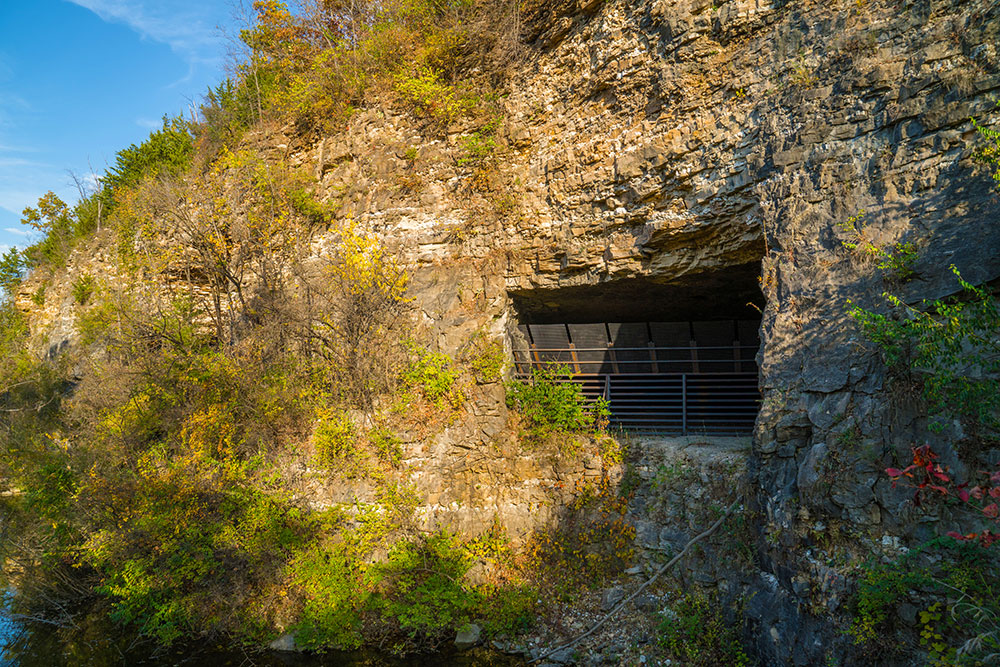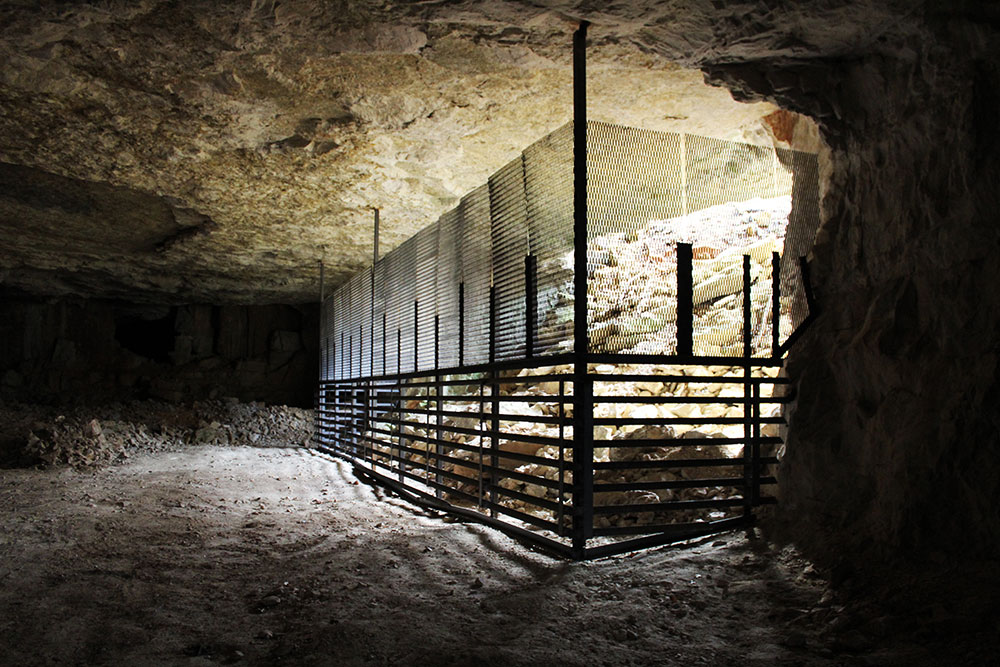In the midnight hour
By Andrea Piekarczyk on September 19, 2016 in Blog

Walking into the dark, yawning entrance of the enormous cave system in Hannibal, Missouri, Iowa Natural Heritage Foundation Conservation Easement Director Erin Van Waus was not quite sure what to expect. Accompanied by INHF President Joe McGovern and staff members from The Conservation Fund (TCF), Van Waus entered the caves through their largest entrance: a gaping maw in the side of a hill, large enough for two trucks to drive into side by side.
McGovern and Van Waus’ trip to Missouri was at the invitation of TCF, which had requested INHF’s assistance with an unusual and exciting project: protecting a former limestone mine providing hibernation habitat for an estimated 168,000 Indiana bats — one third of the known population of this federally endangered species. It is the largest maternal colony of Indiana bats in the world, making the caves’ protection of critical importance.
Around the time of the caves’ discovery, U.S. Fish and Wildlife Service (USFWS) personnel were negotiating a unique and precedent-setting mitigation package for the Flanagan South Pipeline Project that runs from Illinois to Oklahoma through Missouri. The USFWS established measures for avoiding and minimizing impacts to bat and migratory bird habitat from the 600-mile pipeline. Where habitat destruction was unavoidable, the Service worked with the energy company to establish a $22 million fund to compensate for the habitat loss.

The USFWS partnered with TCF to implement a major land protection and restoration program using these funds to benefit migratory birds and threatened and endangered species, including Indiana bats. TCF is a nonprofit that operates on a national scale to advance both conservation goals and economic development. The protection of the former Lime Kiln Mine in Hannibal was chosen as the highest priority project because of its significance to Indiana bats.
After nearly a year of negotiations, TCF was able to purchase the main body of the mine and the surrounding 185 acres of gently rolling woodland. It is, Van Waus later noted, “truly amazing that a place so beautiful and important [for a species like the Indiana bat] could be created from limestone mining.” Together, the project partners decided to rename the Lime Kiln Mine complex after the scientific name for the Indiana bat, Myotis sodalis. They decided to call it Sodalis Nature Preserve.

The world’s leading bat gate designer, Jerry Fant of Karst Solutions, was hired to build bat-friendlygates across each of the caves’ 34 entrances. From the great, yawning mouth to the smallest of crevices, each opening was protected with a custom-designed gate. Cave systems are fragile and complex, so it was necessary to preserve the airflow into the tunnels while also protecting the bats from human intrusion.
Sending out the bat signal
Because of the incredible importance of the Sodalis Nature Preserve hibernaculum, TCF was seeking multiple layers of protection to preserve the area in its natural state. Since TCF does not hold property, the first challenge was finding an entity willing to own the caves and surrounding land. The City of Hannibal embraced the opportunity with gusto.
TCF Midwest Project Director Clint Miller, the driving force behind the project, approached INHF to hold a conservation easement on the property. This easement ensures that the Sodalis Nature Preserve will be permanently safeguarded from development, while still allowing local use of trails in the surrounding woodland and giving USFWS access to the bat caves for research purposes. Miller was particularly excited by this opportunity to have “public recreation and endangered species conservation both benefiting from the same effort.” The two, he said, “can be complimentary.”
And the residents of Hannibal proved exactly that, quickly falling in love with the bats as well as the new space for recreation. At a spring event focused on the end of the bats’ hibernation season, waiting crowds cheered the first tiny animal as it fluttered forth from the mouth of the cave, through the bat gate and into the twinkling twilight.
To gain a fuller sense of the project, McGovern and Van Waus traveled to Hannibal to meet with theproject partners and see the caves for themselves. The cave system at Sodalis Nature Preserve is man-made, blasted into the landscape by the dynamite used by limestone miners. The tunnels are a vast, twisting maze of caverns and crevices that follow no natural logic.

What Van Waus remembers most vividly is the darkness. “Walking into that, it’s amazing how quickly you can get into complete darkness,” she recalled. “You don’t realize that it’s happening because you have a flashlight… But only 100 yards in, everything is completely black.”
The group moved quietly, so as not to disturb the hibernating bats. Playing flashlight beams across the cavern ceilings above, the explorers soon found what they were looking for: small clusters of Indiana bats, huddled closely together. Well, relatively small — each grouping contained 100-300 of the bats, and they can cluster in the thousands. The bats seen that day represent only a small portion of the colony at Sodalis Nature Preserve, which numbers in the hundreds of thousands.
Why INHF?
But why INHF? We are, after all, Iowa Natural Heritage Foundation, and Sodalis Nature Preserve is in Missouri. The reasons are twofold. First and foremost, TCF needed a strong and stable land trust to hold the conservation easement and bat gate maintenance fund. When considering regional partners, Miller was attracted by INHF’s “long history, accredited status and experience dealing with complicated projects.” He said, “I had high confidence in INHF handling such an important project.”
INHF staff and board members believe the protection of the preserve significantly impacts Iowa wildlife, despite its location in Missouri. Indiana bats may migrate up to 200 miles from their hibernacula, which means that many of the Sodalis bats fly to Iowa to live and breed during the rest of the year.
Sodalis Nature Preserve was born from innovation, perseverance and, most of all, partnership. Appropriately, while sodalis is the species name of the Indiana bat, it is also the Latin word for “companion.” INHF is grateful for new friends in unusual places who invite us to greater challenges and opportunities to protect Iowa and its wildlife.